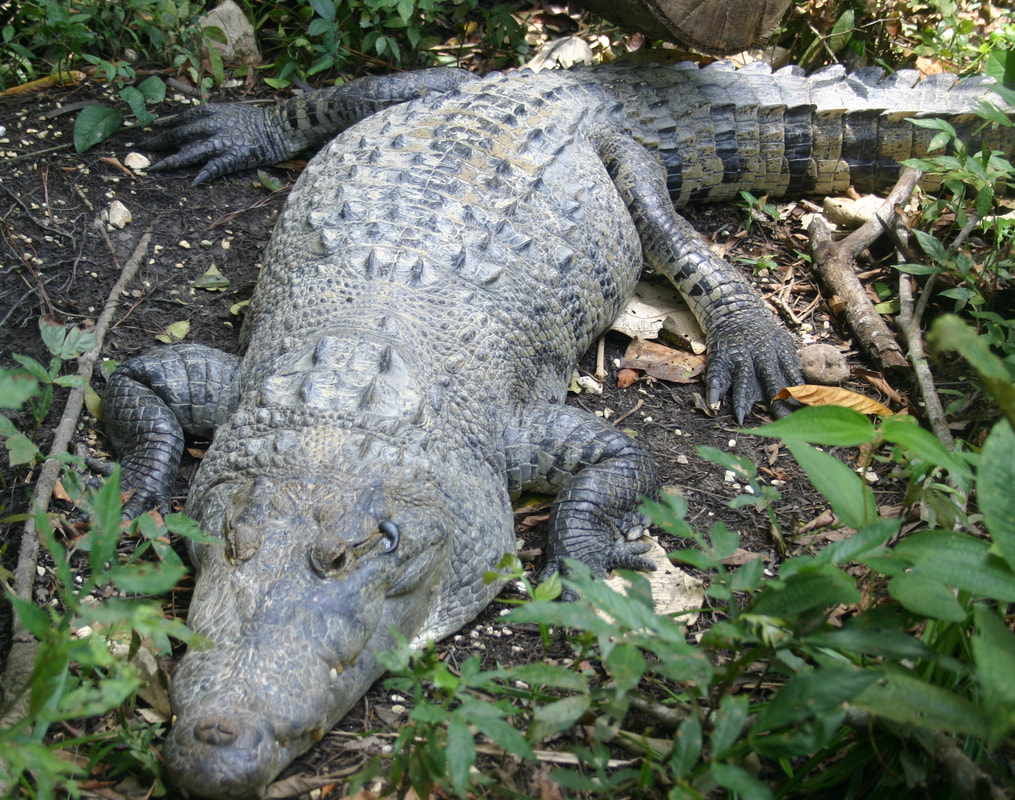 25 INTERESTING FACTS ABOUT CROCODILES 1. Crocodiles can reach (5) feet (1.5 meters) in length in just one year. 2. During mating season, crocodiles display increased aggression. 3. An adult crocodile has 64 teeth that are meant to grasp and crush, not chew. They swallow stones that grind food inside their stomachs, and also act as ballast. 4. Their infant mortality rate is very high. 95% of crocodile offspring are eaten in the first year after birth, by other predators. 5. Crocodile skin is considered one of the finest and is treasured for its durability and softness. It's a sign of status in tribal societies. 6. Some tribes worship the crocodile. This is true of the tribe in New Guinea (where they cut themselves to look like the skin of a crocodile), and it's true of the ancient Mayan people of Belize. 7. They are the biggest reptiles on earth. Saltwater crocodiles are the biggest reptiles in the world. They can grow up to 20 feet in length and can weigh more than a ton. 8. There is also a species called "Dwarf Crocodiles". The smallest crocodile is the dwarf crocodile (measuring 4.9 to 6.2 feet) in length. 9. Crocodiles live all over the globe, except for Europe. 10. Crocodiles are closely related to dinosaurs and birds. 11. Crocodiles really do produce tears. This is because, while they are eating, they swallow too much air, which gets in touch with their lachrymal glands (the glands that produce tears) and forces tears to flow. But it's not actually crying, and crocodiles do not weep when they eat their prey. 12. Crocodiles can keep their jaw open under water. This because there is a valve at the back of their throats, allowing them to open their jaw underwater. 13. They have an average lifespan of 30-40 years, but in the case of large species, they can live on an average of 60-70 years. 14. Their ancestors were much bigger. While this is true, crocodiles are very closely related to dinosaurs. The prehistoric crocodiles were much bigger than today's counterpart. 15. Saltwater crocodiles have the strongest bite. A saltwater crocodile can slam his jaw shut using 3,700 pounds per square inch of pressure. To give you a comparison, a lion can bite with the force of 1,314.7 pounds per square inch of pressure. Despite this enormous bite force, their muscles to open the jaw are extremely small and weak, that is why a human can use their hands to keep a crocodile's mouth closed. 16. Crocodiles have good night vision. Their night vision is very good and they are mostly nocturnal hunters. 17. The crocodile heart is very sophisticated. Of all animals in the animal kingdom, the crocodiles has the most sophisticated heart. It can actively change the destination of blood that flows through it depending on requirements. 18. Crocodiles carry their hatchlings in their mouth. Crocodiles carry their babies to the water in their mouth. Baby crocodiles can make noises from inside their eggs before they hatch. The mother can hear their voices, then digs up the eggs from the sand, and takes the hatchings to the water. 19. They can find their home from long distances. Crocodiles may possess a homing instinct. Crocodiles when tracked in Australia, were relocated, but returned to their original locations within three weeks (information obtained from tracking devices attached to each one). 20. They are good swimmers. Their top speed swimming is 15 mph. 21. Their feet are webbed. Crocodiles have webbed feet which, which they do not use for swimming. They tuck their feet to the side while swimming and use the power of their tails, which allows them to make fast turns and sudden moves in the water. 22. They are cold-blooded. Like other reptiles, crocodiles are cold-blooded. So, they have a very slow metabolism, which allows them to survive long periods without food. They can survive many months on a single large meal. 23. They cannot sweat. Crocodiles do not have sweat glands and release heat through their mouths. They often sleep with their mouths open. 24. Crocodiles don’t chew their food. Many large crocodilians swallow stones, which may act as ballast to balance their bodies or assist in crushing food, similar to grit ingested by birds. 25. Crocodiles are amphibious. They are amphibious reptiles, spending part of their time in water and part of their time on land. Although the saltwater crocodile and the American crocodile are able to swim out to sea, no living species of crocodilian can be considered truly marine. Common misconceptions about crocodiles - Here are some misconceptions about crocodiles:
0 Comments
 In Belize we say "alligator" in reference to our largest reptile, when it fact we mean crocodile. That's how it is down here, we call things by all different names, other than what their real name is. As a matter of fact, it is their teeth, that make the difference between whether its a crocodile or an alligator. When the reptile closes its mouth, the elongated tooth on each side of its huge lower jaw fits into a notch on the outside of the upper jaw - it's front teeth also hang out, over its chin; when the reptile closes its mouth. If you see this, then it's a crocodile, not an alligator. Can you see in the picture above, how the crocodiles front teeth are hanging over his lower jaw? We'll that's a characteristic of a crocodile. These animals move by the temptation of the flesh, ANYONE'S FLESH! For hours on end, they will lie in wait - in excellent imitation of a log, their ears, eyes and nostrils aligned upon the water, with their powerful tails executing secret maneuvers beneath the surface. Their skin is as tough as their outlook on life, and because of this, they have the tendency to endure and survive. Crocodiles will continue to grow throughout their lives. Salt-water crocodiles are the largest, some measuring 23 feet and weighing over a ton. Our Morelet's crocodile, is one of the smallest, attaining a length of only 8 feet, but our other species, the American crocodile, grows decidedly longer. These beasts like to hang out near creeks, ponds, streams, rivers, lagoons. They like to hide in mangrove swamps or storm-tide lowlands. Believe it or not, the male actually goes a courting, first staking out and patrolling a chosen aquatic territory. All alligators and crocodiles are egg layers, and have a high reproduction rate - necessary to counteract their propensity for eating their own young. Between 20 and 70 eggs are produced and either left above ground or plastered up in security vault made of mud and grasses, near a water source. It conditions, temperature and humidity remain stable within the chamber, it will take about 74 days for these eggs to incubate. When they are ready to attack the world, these little hatchlings begin to squeal to attract the attention of the adults to come and let them out (or eat them!). They are tended by their parents for up to four months, and the young may stay in the vicinity of the nest for as long as eighteen months. Initially they feed on water bugs, then on fish and frogs, and carrion. In turn storks, egrets, and herons, raccoons and foxes feed on them, and the degree of mortality is acute. However, if they do manage to survive, only men and anacondas are enemies of the adult crocodile. |
Is located on the island of Ambergris Caye, directly across from the Belize Barrier Reef, off the mainland coast of Belize. The property is nestled in a cluster of Australian Pine trees, backed to a littoral jungle, and surrounded by tropical gardens. It's about a one minute walk from the property to the beach, and a 10-15 minute drive from the island airstrip to the property.
We offer one bedroom suites (455 s.f.) of living area to include: livingroom, kitchenette, private bathroom and bedroom. We are also about a one minute walk from one of the best restaurants on the island serving (breakfast, lunch & dinner). Within walking distance you can find: (3) blocks is Robyn's BBQ (4) blocks is 2 fruit stands (5) blocks local grocery store IF YOU'RE COMING TO BELIZE TO............... If you're coming to Belize to dive the Blue Hole, descend the shelf walls at Turneffe, snorkel the Barrier Reef, explore Mayan ruins, rappel into a cave, kayak along the river through caves, zip line through jungle tree tops, hike through a cave to see an ancient human skeleton, swim with sharks, listen to Howler Monkey's, hold a boa constrictor, feed a jaguar, horseback ride through the jungle, canoe through a cave, rappel down a waterfall, sail around an island, enjoy cocktails & dinner to a sunset, climb 130' feet to the top of a Mayan ruin, rip up the jungle trails on an ATV, float through a series of caves on a tube, and sip on a rum punch..... then this is the place for you. Belize Budget Suites, offers you clean, affordable, attractive, accommodations, at prices that allow you to do all the things just mentioned. Archives
February 2021
Categories
All

For All Your Home Improvement Needs

For all Your Real Estate Needs
501-226-4400 10 Coconut Dr. San Pedro, Belize Your Ad Could Go Here
|











 RSS Feed
RSS Feed























